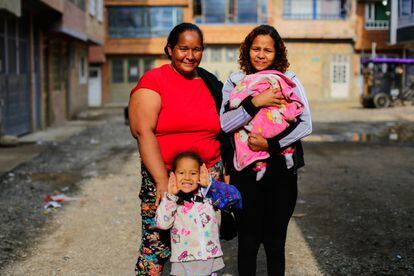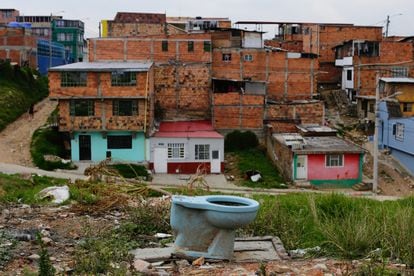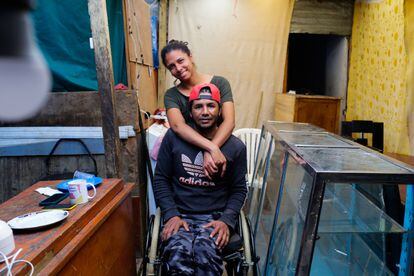It is five in the morning, the Andean air of Bogotá is freezing, and Saray, a four-year-old girl, walks through the garbage, mud and sand. She hasn't eaten anything yet and she holds tight to the hand of her mother, Omaira, to seek shelter and food at the nearest kindergarten. The two must walk two kilometers to get to the place because they do not have 6,000 pesos (1 and a half dollars) to take a pedicab transportation that will move them faster. It doesn't matter, because Omaira, her mother, knows that Saray cannot miss a day in the garden: if she stayed at home, Saray would only be able to have one of the three meals of the day. The two, mother and daughter, are Venezuelan and part of the thousands of migrants who left the crisis in Venezuela to seek a better life in Colombia. In Bogotá they found a refuge, in a rarely visited neighborhood, which paradoxically has the name of the leader who transformed their country: the Hugo Chávez neighborhood. A neighborhood where many Venezuelan migrants know that, although Caracas does not experience the same crises as Bogotá, here and there misery has a very similar face.
Bogotá today hosts at least 572,000 Venezuelan migrants, according to figures from ProBogotá and USAID, delivered last March. And 60% of these migrants are settled in the towns of Engativá, Ciudad Bolívar, Suba, Kennedy and Bosa. El PAÍS took a tour of the Hugo Chávez and República Venezolana neighborhoods, two where the vast majority of the inhabitants are migrants—between 80 or 90% of the people. If it weren't for the cold climate, these small Venezuelas could very well resemble Caracas or Maracaibo, where their voices sound more chamos than parceros. Like Saray, the 4-year-old girl, more than 300 Venezuelan children live in the Hugo Chávez neighborhood.
The Hugo Chávez neighborhood is the informal name, its official name is Unir II. It is an invasion neighborhood located in the town of Engativá, in Bogotá, which has around 4,000 inhabitants, of which 80% are Venezuelans. Hugo Chávez, the neighborhood and not the leader, started years ago as a large piece of land where the city's recyclers arrived with their pack horses. But one day Mariano Porras, a landowner and faithful follower of Chávez, arrived there, who in 2005 bought the land and then decided to sell lots for 1 million pesos (260 dollars). The idea is that it was a home for migrants from Venezuela and they, indeed, arrived. They improvisedly made several houses with wood, brick and bahareque.
The first to be built was “the old house”, located in the center of the neighborhood and from there towards the back they continued to build – without a license – houses that have between four and five floors upwards. Eight to ten people live on each floor, all related to each other, so about fifty Venezuelan people live in each building. In the case of Omaira and Saray, they both live in a 4-story house with 4 other Venezuelan families, and they are all old acquaintances from Maracaibo.

Newsletter
The analysis of current events and the best stories from Colombia, every week in your mailbox
RECEIVE THE
But, according to the Police, this is today one of the four most dangerous neighborhoods in the entire capital. Its own inhabitants say that whoever enters to run a home or provide a public transportation service runs the risk of never leaving. “Since no one dares to enter here, they won't find them,” says Omaira, Saray's mother. Members of the feared Venezuelan criminal gangs such as El Tren de Aragua, Los Rolos and Los Costeños have been captured in the neighborhood carrying out drug trafficking operations, thefts and murders. There are frequent reports of disappearances and even cases in which bodies have been found in the Jaboque wetland —next to the neighborhood. When Saray, 4 years old, walks through the neighborhood, her mother not only walks through the cold but also through fear.
Why leave Caracas for an equally unsafe place? “At least here in Colombia my husband can work, in Venezuela we were quiet,” says Kimberly Ramírez, one of Omaira's neighbors. I work poorly paid, but I work at the end of the day.
Republic of Venezuela, an invasion in Ciudad Bolívar
In the middle of one of the steep hills of Ciudad Bolívar, one of the poorest towns in Bogotá, is República de Venezuela, an invasion neighborhood made up of 90% Venezuelans. When you get there you have the feeling of being, not in a neighborhood, but in a group of houses where everyone knows each other: the vast majority have their relatives as neighbors.

gotá.ANDRES GALEANO
Unlike Hugo Chávez, in the Republic of Venezuela there was no landowner selling land: the migrants who arrive settle day by day wherever there is space, it's that simple. The houses are built of wood and aluminum tiles, with two or three divisions across the width, where eight to ten people live. Unlike Húgo Chávez, República de Venezuela is not formally legalized as a neighborhood, and lives completely informally—the electricity comes with cables from the neighboring neighborhood, the water is taken from a nearby natural source. There is no aqueduct, there is no electrical network.
Alexander, 34, sits in his wheelchair in the entryway of his scrap-wood home. Eight years ago he left Valencia, Venezuela, in search of work. He managed to work as a mechanic in a company near Simón Bolívar Park in Bogotá. He was happy, life was finally smiling at him, he thought that now he was going to get out of misery, that something similar to the 'Colombian dream' was approaching. Until one morning in 2022, when he had a traffic accident going down the hill where he lives towards the center of the city, and now he can't walk. “Did I return from Venezuela to ask for money at traffic lights out of pity?” He asks. He came to look for opportunities, a future, he did not come to beg. He did not leave the poverty of the Republic of Venezuela to live in the poverty of the other Republic of Venezuela.

Not far from him lives Yeimi Carreño, 42 years old, she migrated from Venezuela in 2015 and in Bogotá she has been a recycler, cleaner and bricklayer. Sometimes she was forced to leave her two children alone, because she had no one to take care of them and this brought her problems with the Colombian State. The Colombian Family Welfare Institute (ICBF) began a process against her a few years ago to remove her custody of the minors—which ended up being resolved in her favor, with the support of her husband, who moved to Colombia upon learning that they were at risk. the risk of losing both children. “We are grateful to Colombia,” she says. She says it despite the abandonment of the neighborhood, despite the fact that her children were almost taken away from her. She doesn't leave. They are currently moving to a new house, built by her and her partner, in the Venezuelan Republic of Bogotá. The raindrops are felt on its roof made of aluminum cans. It is colder than Caracas, and perhaps just as poor or dangerous as Caracas, but no no, it is not Caracas.
Subscribe here to the EL PAÍS newsletter about Colombia and here to the channel on WhatsAppand receive all the information keys on current events in the country.
#Hugo #Chávez #Venezuelan #Republic #neighborhoods #Bogotá #Venezuelans #survive #misery